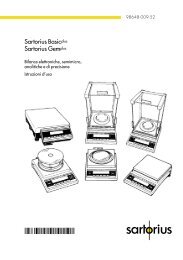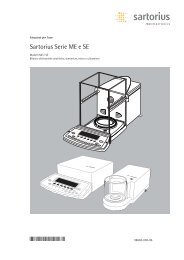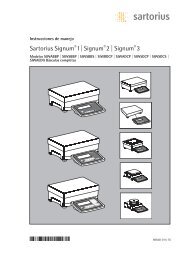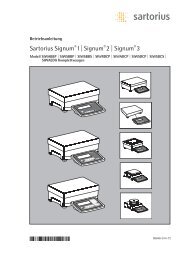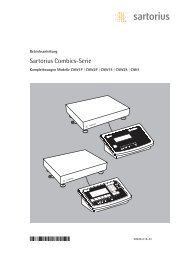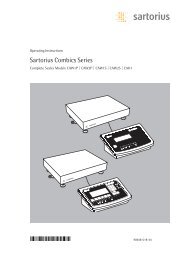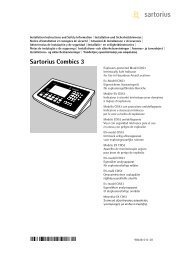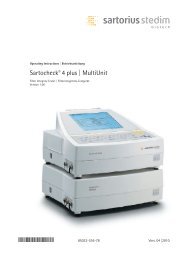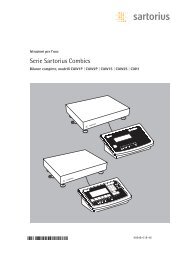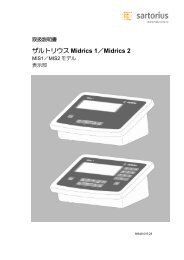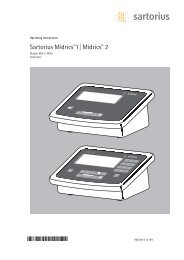MAN-Combics Complete Scale CAW3P CAW3S CAH3-e - Sartorius
MAN-Combics Complete Scale CAW3P CAW3S CAH3-e - Sartorius
MAN-Combics Complete Scale CAW3P CAW3S CAH3-e - Sartorius
You also want an ePaper? Increase the reach of your titles
YUMPU automatically turns print PDFs into web optimized ePapers that Google loves.
Analog/Digital Converter (ADC)<br />
Purpose Adjust the parameters of the analog/digital converter to the connected load cell or<br />
weighing platform. After ADC configuration, the ADC in connection with the load<br />
sensor is defined as a scale.<br />
3 Once<br />
the ADC configuration has been locked, the indicator can no longer be used<br />
to influence weighing results. The scope of functions available in the weighing<br />
instrument is defined by the A/D converter. Weighing functions that can be<br />
activated include reading weight values, taring, adjustment, reading the tare value,<br />
saving/deleting the tare entry.<br />
Setup Information – ADC configuration is only possible when the menu access switch is open.<br />
Re-close the menu access switch after ADC configuration.<br />
– Before ADC configuration, you must first set whether or not the weighing<br />
platform will be used as a standard or verifiable weighing platform.<br />
– ADC configuration is carried out in the Service mode in the Setup menu under<br />
“WP 1“ for the first weighing platform and “WP 2“ for the second.<br />
– Entries made in ADC configuration will not be affected by a menu reset<br />
(returning the setup parameters to their factory settings).<br />
See also the overview in the “Setup Menu for A/D Converter Configuration“ section.<br />
Setting Parameters for ADC Configuration<br />
Configuring Weighing Platforms<br />
Standard or Verifiable Configurations In ADC configuration, you must first select whether the weighing platform should<br />
be configured as a standard or verifiable (for use in legal metrology) weighing<br />
platform.<br />
– Standard configuration “Standard“<br />
– Verifiable configuration “Verifi able“<br />
Select using the “Q“ or “q“ soft key. Press the “O“ soft key to confirm the setting<br />
and open the Configuration menu.<br />
Accuracy Class This menu item is not shown when the Standard configuration is active. When<br />
the Verifiable configuration is active (for weighing platforms verified or verifiable<br />
for use in legal metrology), only Class l/m can be selected. Activate the<br />
“Accuracy class“ menu item, select “Class III/IIII“ and<br />
confirm your selection using the “l“ soft key.<br />
Ranges The capacity of the weighing platform can be divided into multiple ranges:<br />
– “ Single-range mode“:<br />
The entire weighing range is divided into scale intervals on the basis of the<br />
lowest interval d and the maximum load.<br />
– “ Multi-interval mode“:<br />
The “Multi-interval mode” function divides the weighing capacity into as<br />
many as four ranges, each with a different readability. Corresponding changes<br />
take place automatically. Once the scale has been tared, the highest possible<br />
resolution is available even if the weighing platform is loaded with a higher<br />
weight. This is only permitted in the accuracy classes l/m for the verifiable<br />
configuration.<br />
– “ Multiple-range mode“:<br />
Multiple-range mode has two or three weighing ranges. When the range limit<br />
is exceeded, the scale switches into the next highest weighing range (lower<br />
resolution) and remains there. The scale can be returned to the lower weighing<br />
range (higher resolution) only by pressing the ( key and then unloading the<br />
scale.<br />
Operating Instructions <strong>Combics</strong> <strong>Complete</strong> <strong>Scale</strong>s 25



